In North West Tasmania, an innovative wearable art competition is gaining global recognition, and it sees paper celebrated on the catwalk. Lyndal Thorne is the director of 'paper on skin', a unique competition which challenges artists to create wearable fashion made out of 80% paper. Despite this year's challenges, Design Eye Creative paper on skin has gone from strength to strength, and in 2020 had 7 countries represented in the 30 works. Young women from Project O helped behind the scenes.
“The process of making paper is so interesting. There’s something lyrical about paper, a little bit quieter, a bit more story related. Then there’s the lineage of paper and what paper means to humanity.” -Lyndal Thorne, Director paper on skin.
Lyndal Thorne has been absorbed in works of paper for several years, not merely works on paper, but wearable art made out of paper. As the Director of Design Eye Creative paper on skin, she has seen this unique exhibition presented by Burnie Arts Council go from strength to strength. A biannual wearable art competition which premiered in 2012, paper on skin has become a signature event for North West Tasmania and is now recognised in the international arts scene, with artists applying from the US, Germany, Venezuela, Portugal, Romania and the Netherlands in 2020.
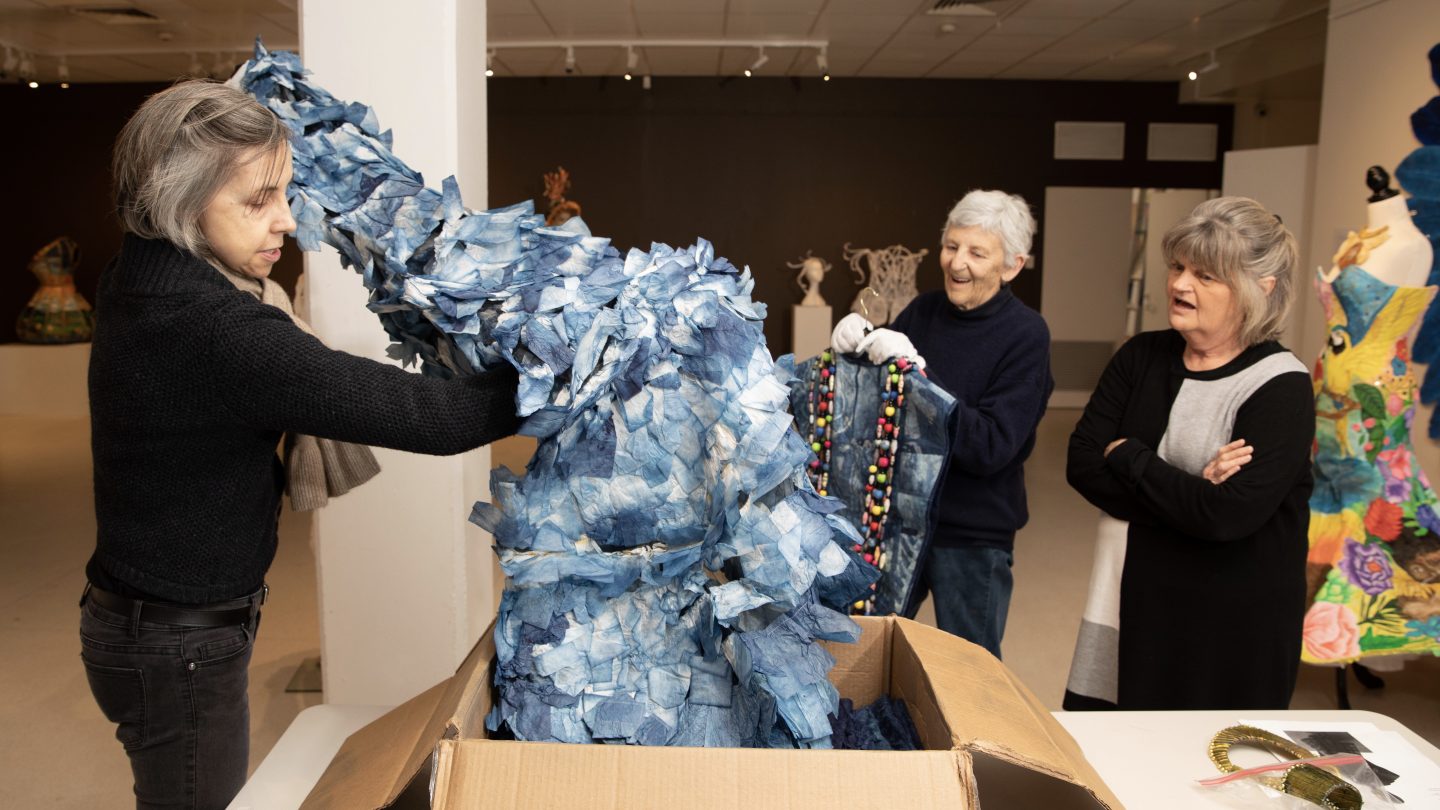
Lyndal Thorne director of paper on skin (left) unboxing the work of Tony Williams’ (USA) ‘Indigo Ripple‘, 2020. Photo: Grant Wells
The lyricism of paper
“It’s just such an interesting challenge for artists to bring their art to life”, says Lyndal Thorne. “There’s something about making these garments that are designed to go on a human body that adds a whole other dimension to the creative process.”
paper on skin was inspired by Burnie’s history as a paper-making town and conceived by Paper Artist Pam Thorne, (Lyndal’s mother), whose papier mache sculptures fill the streets of the former pulp mill town of Burnie. Believed to be one of the few wearable art competitions of its kind in the world which focuses singularly on paper, the challenge for artists is to design a wearable garment made of 80% paper.
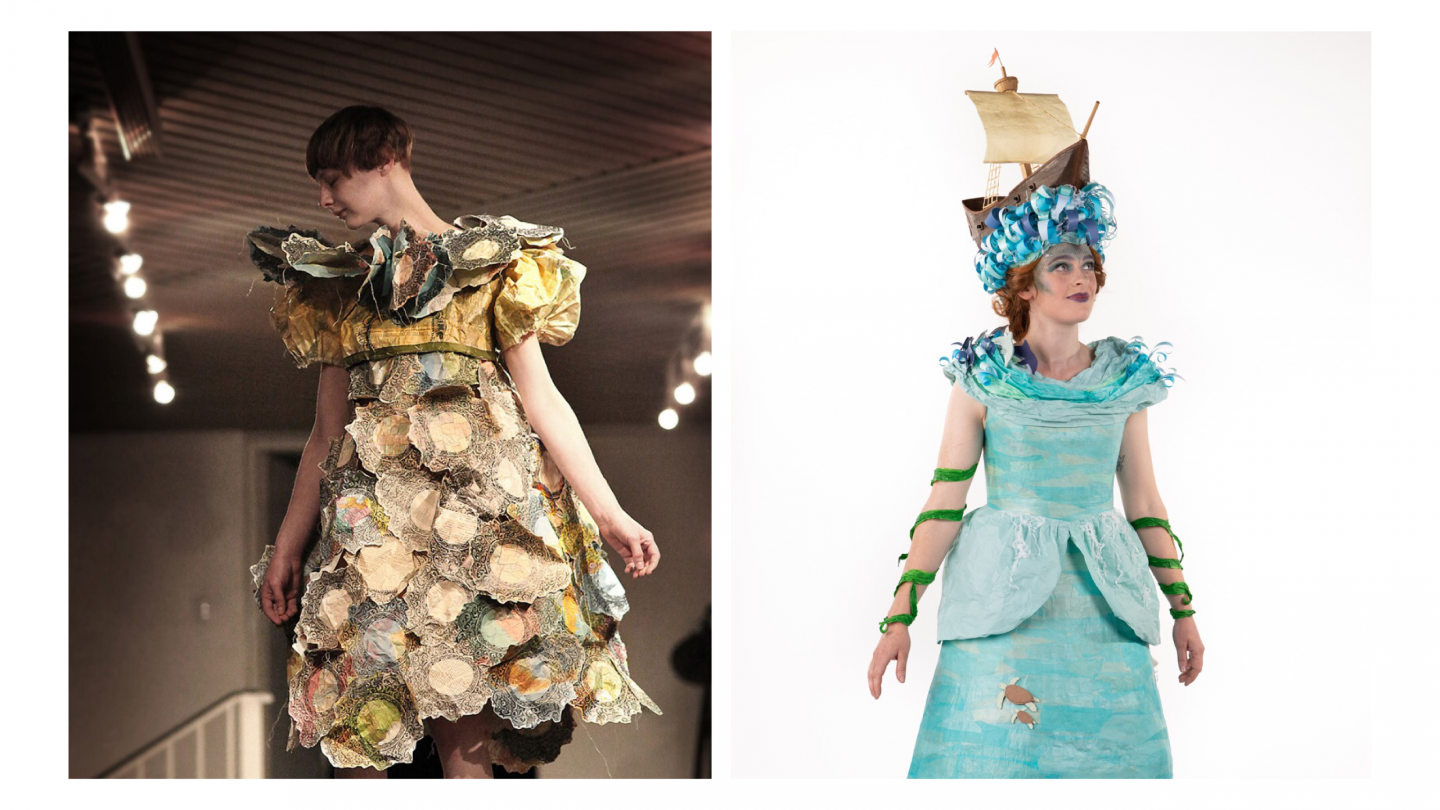
(Left) Leonie Oakes’ 2012 work ‘With Shadows that were their nightgowns’ Photo: Jessica Turale. (Right) Marion Kennedy (TAS) ‘Fathoms’, 2020 . Photo: Grant Wells
“We get these incredible intricate artworks. We never get two pieces that roll in the same – I think that’s partly because it is a challenging task”, says Lyndal. “You’ve really got to want to be in this competition, it’s going to take over your life for a few months. 80% has to be made of paper, it’s got to be wearable. So the commitment really has to be there. There’s a lot of trial and error which I like because that’s encouraging people to make art.”
The 2020 works were bold, wild, ingenious and earthy with frocks, capes, shoes, boleros and body masks all created from paper. The innovation of technique and materials is equally diverse with artists incorporating paper braiding, recycled toilet paper and tea bags, native grasses, lichen and sacred geometry, with other works inspired by composting, coming of age and Australia’s first peoples.
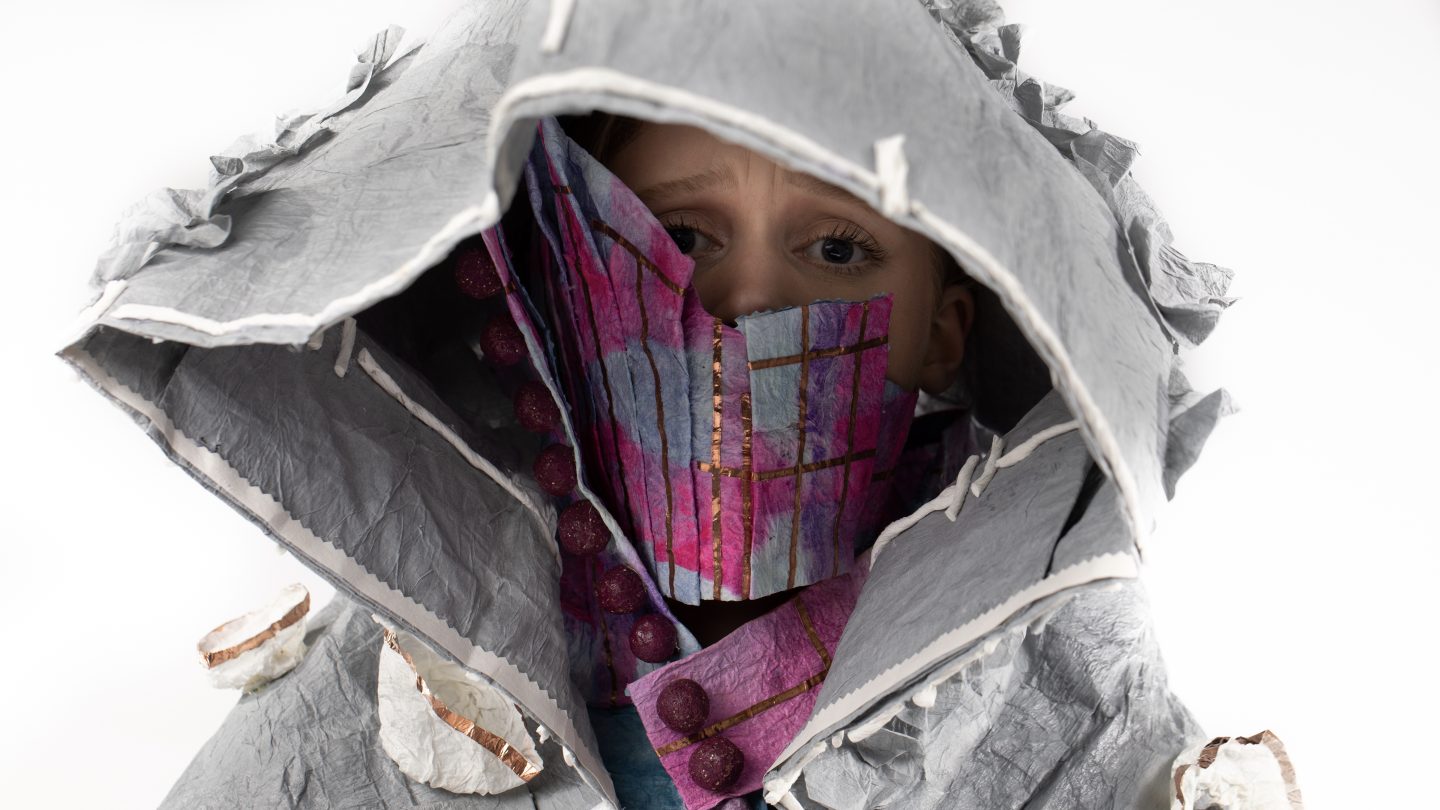
‘Foggy Lady’, by Netherlands Artist Mali Klein, 2020. Photo: Grant Wells
Lyndal Thorne cites one of the most interesting international works is from Netherlands Artist Mali Klein, who used paper waste, handmade paper and natural pigments in her work ‘Foggy Lady’. Submitted prior to COVID, Mali’s work is strangely on point with its protective garments of face mask, mittens and cloak, created originally to make a statement about air pollution and the western world’s dependence on the heavily polluting textile industries.
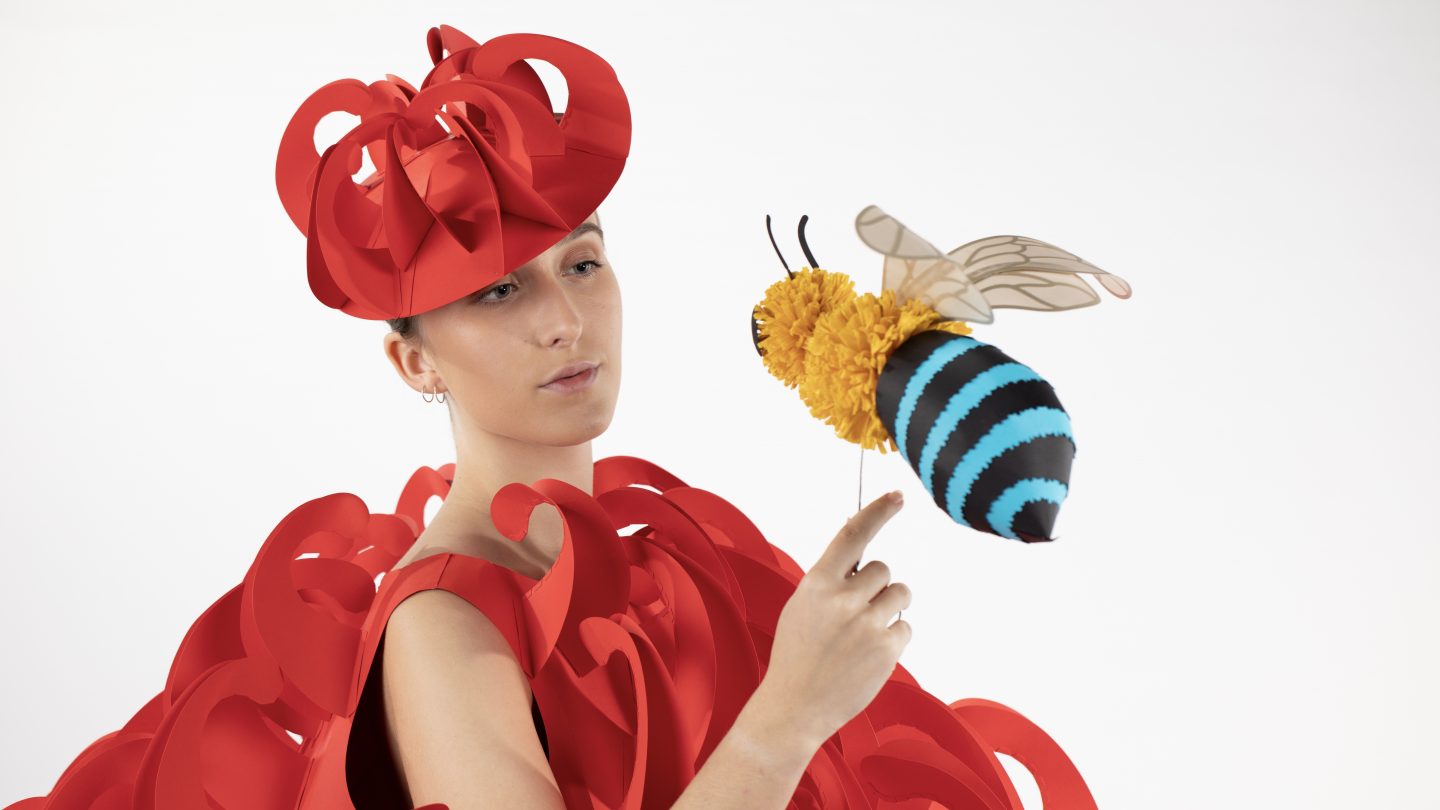
‘Waratah’ by Amanda May (VIC), 2020 Design Eye Creative Major Award Winner. Photo: Grant Wells.
The 2020 Design Eye Creative Major Award Winner was ‘Waratah’ by Victorian artist Amanda May, made out of 225gsm uncoated, carbon-neutral paper. Lyndal Thorne says “From a design perspective it’s quite complex but deceptively simple in its final execution. Amanda May plays with scale and there’s this lovely message about bees and pollination as it features the blue banded bee which is very important to Australia’s ecology.”
COVID challenges
This year paper on skin had the extra challenge of being presented in the midst of COVID.
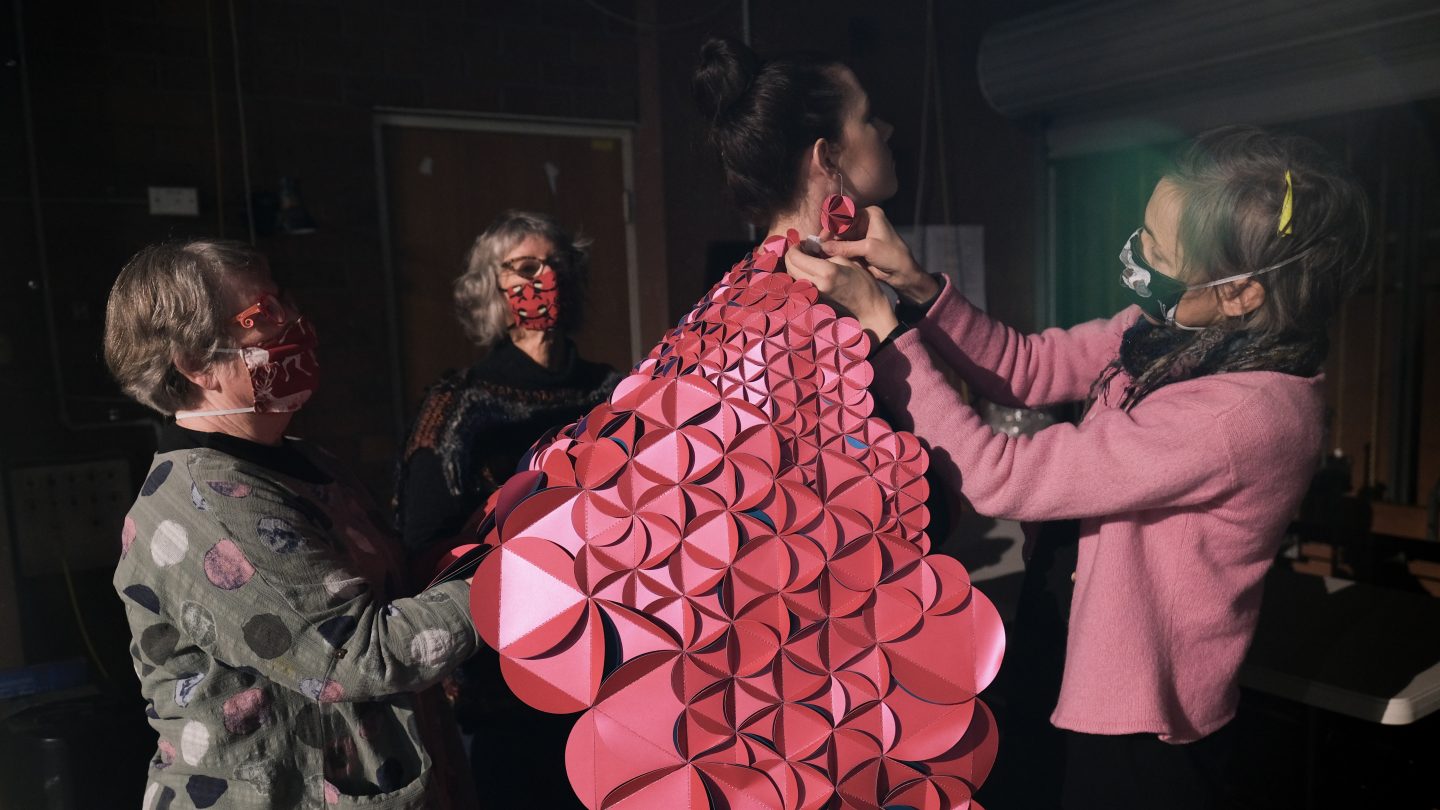
COVID challenges. paper on skin team with ‘Flower of Life’ (USA) by Brielle Killip, Chris Geissinger and Jennifer Garber. Flower of Life was the winner of the 2020 Honourable Roger Jaensch Runner Up Award & the Cocoon Designs Public Vote Award. Photo: Grant Wells
Whilst artists dealt with freight challenges, on the ground in Tasmania public events were banned, so it was no longer possible to host the hugely popular award night with gala parade. However, the team were determined to soldier on. They were committed to the artists who had been working around the clock on their pieces, and found a way around restrictions. Instead of having a public event they would take paper on skin 2020 online, with a digital announcement of the winners and a film which showcased the wearable artworks on models. Project O Producer Clare Spillman became the floor manager for the film shoot and young women from Project O were asked to be part of the film and production team.
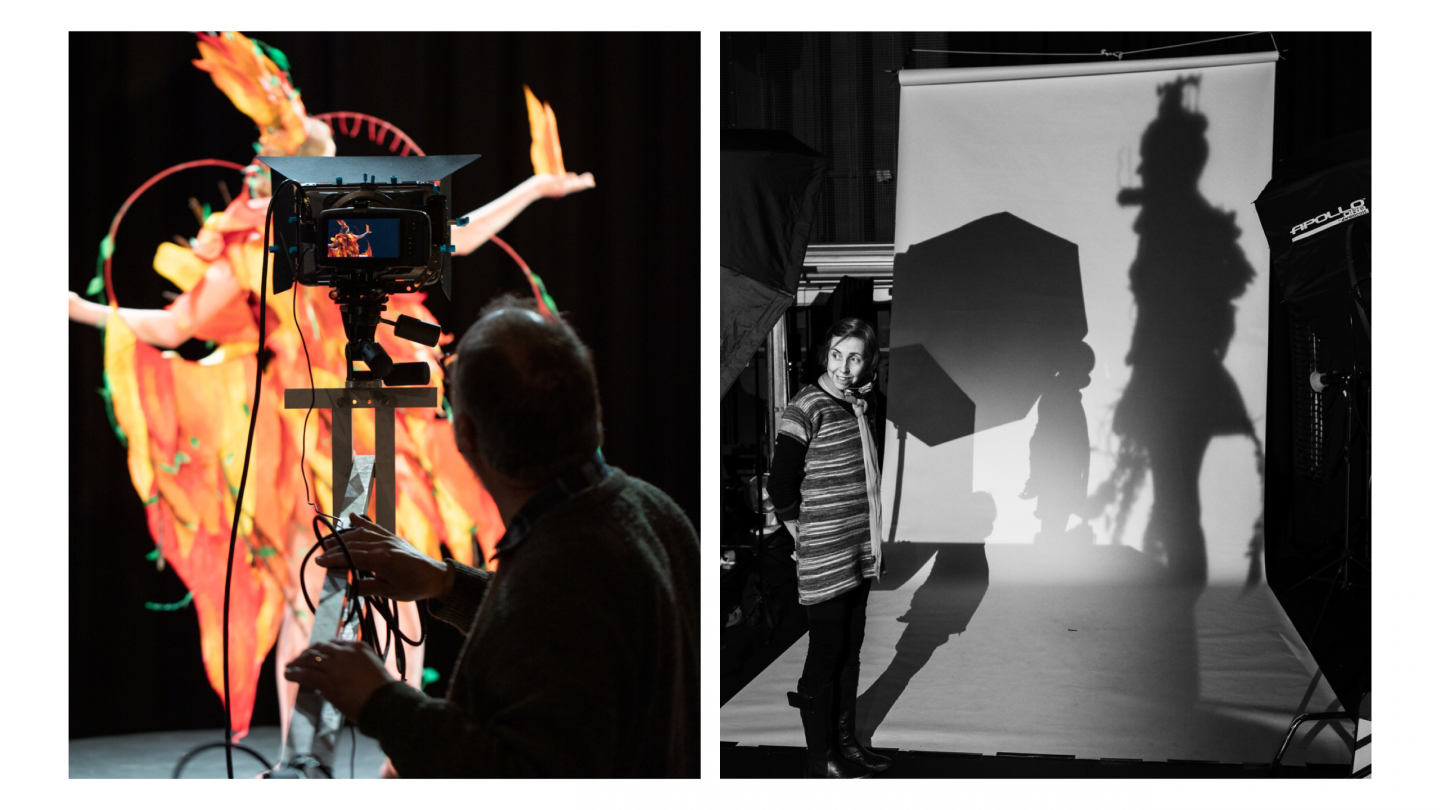
Shooting the film of paper on skin, 2020. Shooting ‘Flame’ (left) and Lyndal Thorne on set (right). Photo: Grant Wells
“paper on skin is a really good example of how going digital has become a really great positive during COVID”, says Claire Spillman, Producer of Project O.
“Despite COVID, it’s become a much bigger thing” says Lyndal. “It hit some other level in the stratosphere this time. I’m just understanding how much global interest there is.”
Project O discover new opportunities
Chloe Keely is one of the young women from Project O who helped on set. She worked very closely with the models, handling each wearable artwork, many were extremely delicate and fragile, so much care was needed.
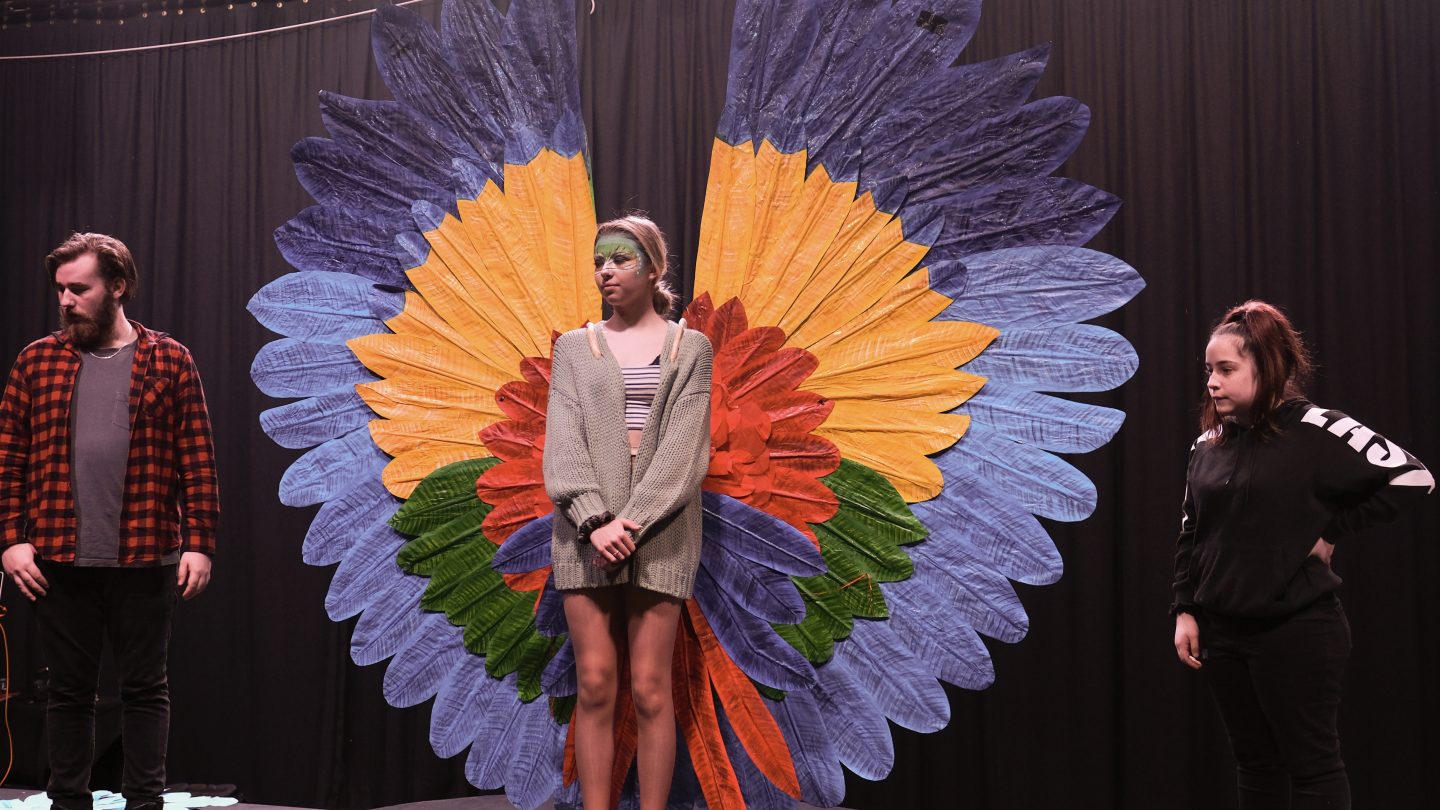
During rehearsal. Technical Assistant Filip Wyker (left) with Chloe Keely of Project O (right) with ‘Queen Guacamaya’ by Lorenny Vera (Venezuela). Photo: Grant Wells
“What I enjoyed most was seeing all the models and all the costumes first-hand. I really enjoyed working with Giovanna from En Vogue Modelling Academy” says Chloe Keely. “My favourite artwork was ‘Fathoms’, by Tasmanian Artist Marion Kennedy. There is so much detail that’s been put into it.”
Chloe also assisted filmmaker Nicholas Higgins – helping with the scheduling of the filmmaking day and the production demands on set.
“What was most challenging was just keeping track of what I had to do. The biggest thing I learnt was how to manage my time and how to stay calm”, says Chloe. “If I was to do it again I’d be more confident, I wouldn’t be as scared. It was a really fun experience.”
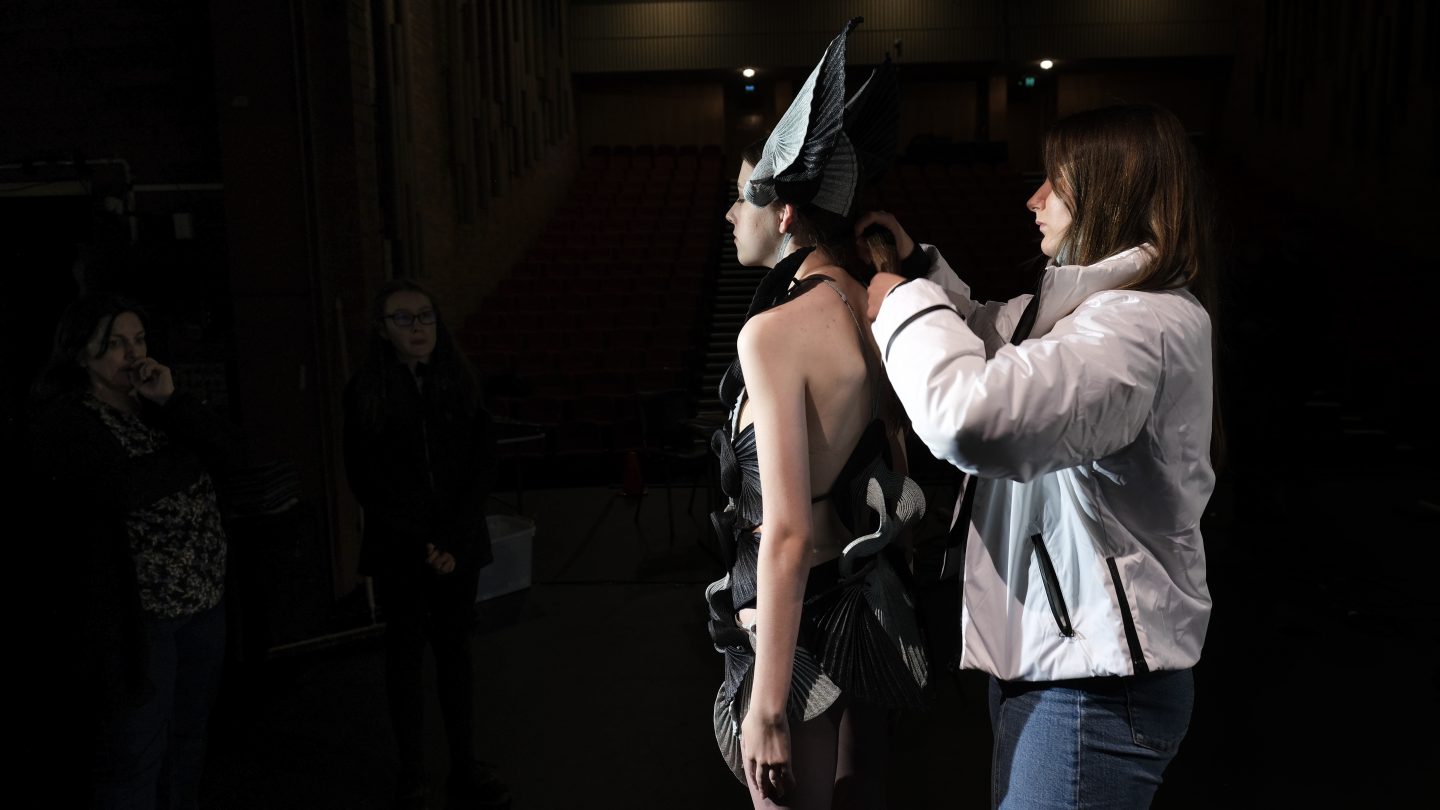
Dressing models. ‘Calligraphica’ by RR Pascoe (NSW), 2020 (Highly Commended). Photo: Grant Wells
“Paper on Skin has widened their world. They discovered a new artistic outcome, that is wearable art made out of paper” says Claire Spillman speaking on the benefits for Project O young women being involved. “For them to see that this is a career for some people, it really widens their perspective on future pathways.”
“Project O were so pivotal to paper on skin”, says Lyndal Thorne. “It’s such a team effort to get something like this happening. There was a lot of learning going on across the whole team, but a real commitment as well, to make sure that everything happened as best as we could. The Project O students can be rightly proud to have been integrally involved in the production.”
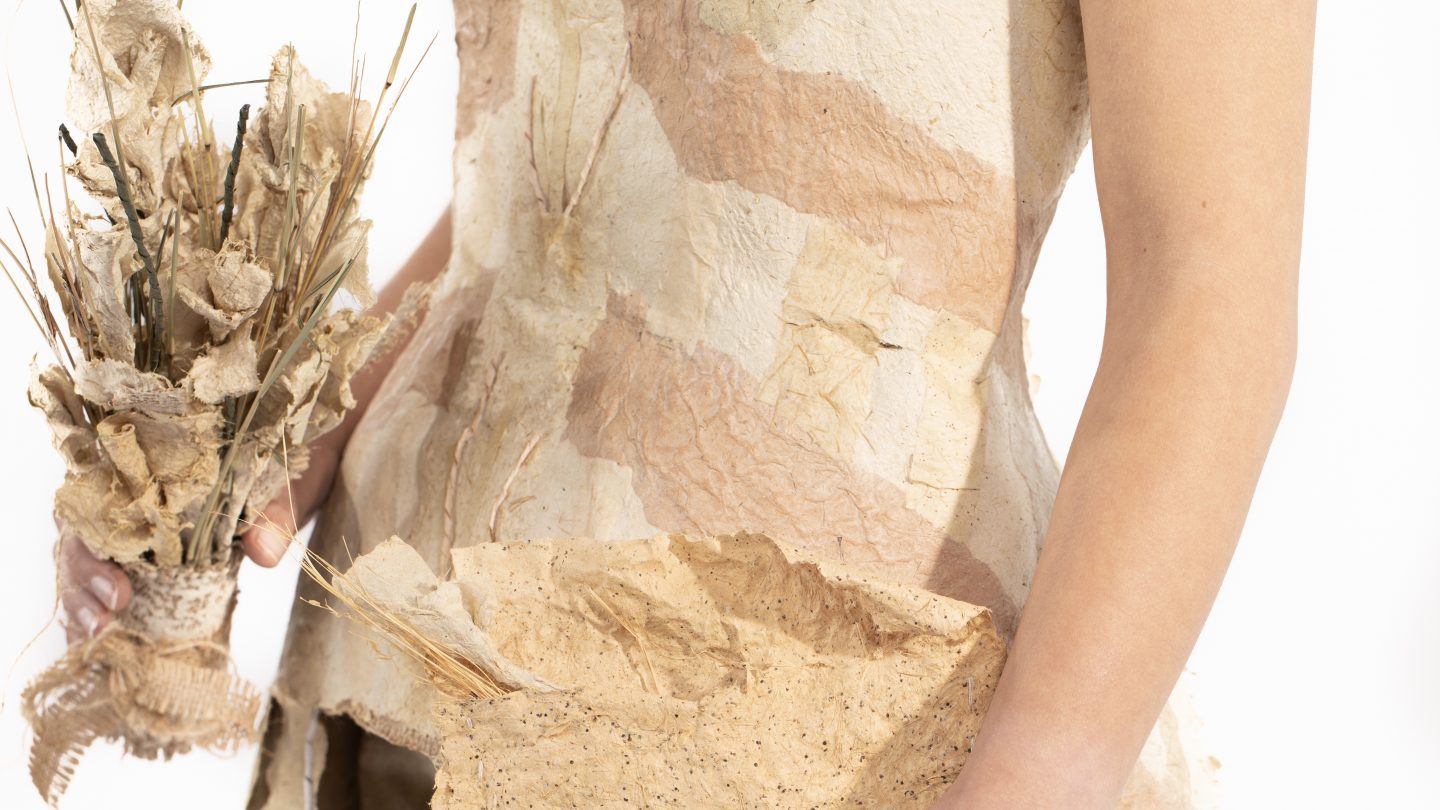
Detail from ‘Study of Grass’ (2020) by Amee Dennis (NSW). (Highly Commended). Photo: Grant Wells
Global potential of NW Tasmania
Lyndal says that the spirit of that north west coast of Tasmania was really noticeable on the set – cooperation, problem solving, resourcefulness and a real generosity.
“paper on skin reinforces that the things which happen in our region can absolutely be world class” says Lyndal Thorne. “The more projects and events like this happen, the more confidently we can stand as a community, and say ‘hey – there’s a lot going on here – let’s make sure people know about it and we keep creating these experiences’.”
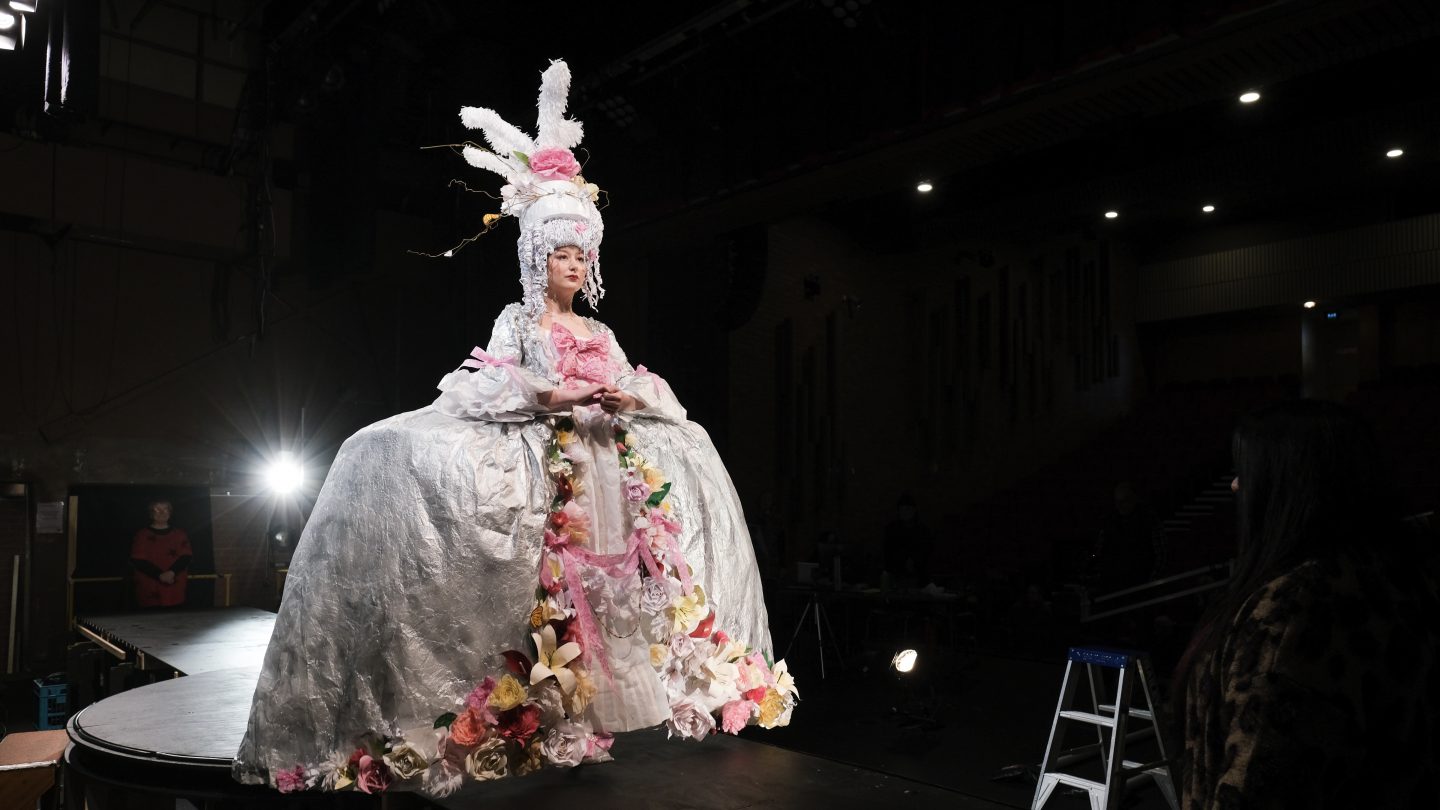
‘Let Them Eat Cake’ by Joan Stammers (TAS), 2020. Photo: Grant Wells
Claire Spillman also speaks of the importance of the North West, changing perceptions and the opportunities it can bring for the young people Big hART works with.
“Getting involved in projects like paper on skin, the North West of Tasmania is recognized internationally as an important place to be, an award winning place” says Clare Spillman. “It’s vital for young women to hear from different voices and in different contexts, and have all those different understandings, that whatever path they want to follow, they just have to identify that path.”
paper on skin have just released their feature film, watch here. To find out more about paper on skin visit their website.
Project O is an initiative of Big hART and enables young women to be change-makers in rural and disadvantaged communities. It currently operates in Wynyard and Smithton in NW Tasmania, Frankston Victoria & Roebourne WA. More info: https://projecto.bighart.org
Article by Bettina Richter.
